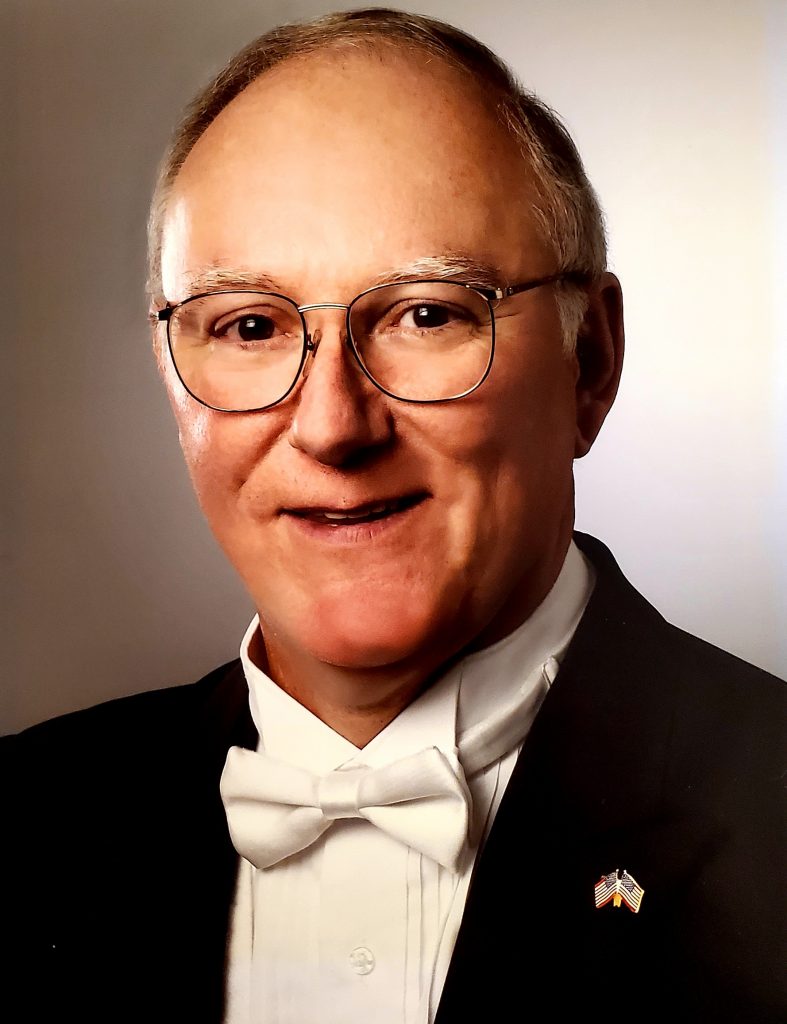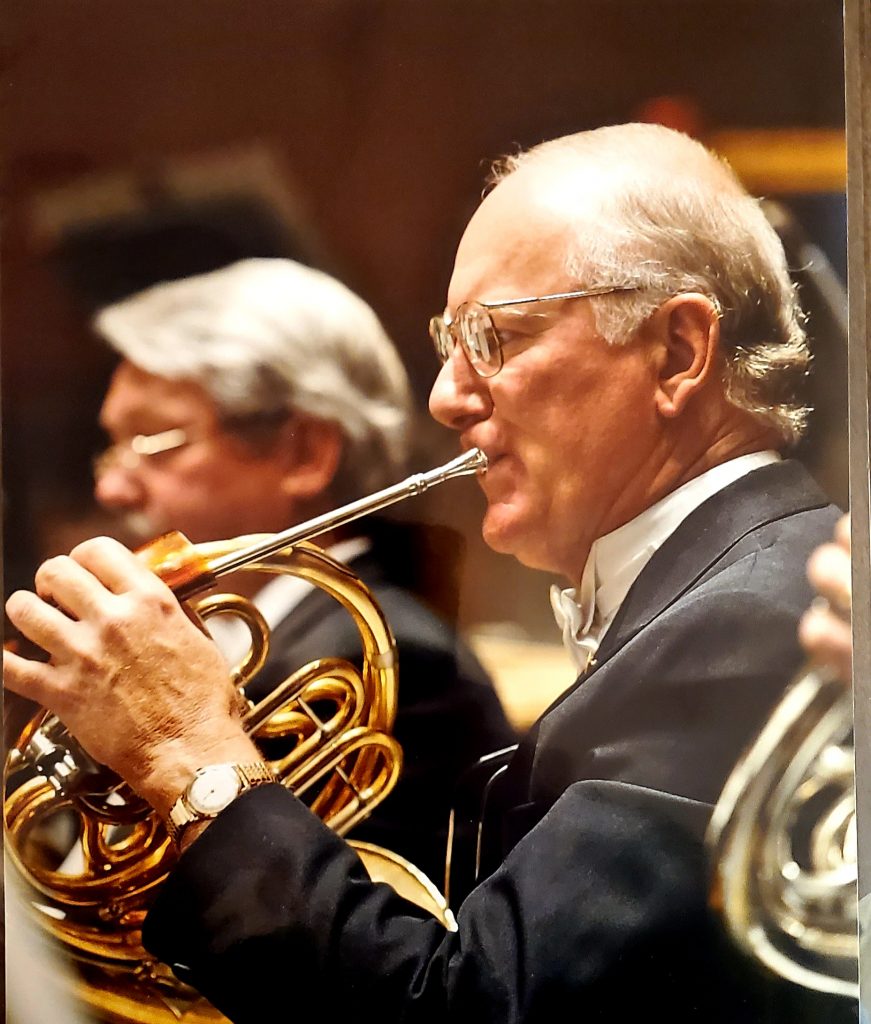Peter G. Kline – In Memoriam

On Tuesday December 28th, 2021, Peter G. Kline (Pete) passed away in Central Florida. Pete was born on August 15th, 1941 in New Brunswick, New Jersey and spent his formative years in Lake Wales, Florida. His love of music was inspired by listening to radio broadcasts with his father; Frankie Lane and his Orchestra left a lasting impression on young Pete. His mother, Connie, became his piano teacher after Pete’s failed attempt at dance lessons. Ultimately, Pete was introduced to the horn in 1950 when his uncle Rob Gustat played horn for him on a family visit. Rob was the Third Horn of the St. Louis Symphony Orchestra at that time and played on an instrument that would eventually become Pete’s. Pete was so dedicated to the horn at a young age that in order to attend his weekly lessons, he drove the family car on a 104-mile round trip from Lake Wales to Tampa every Saturday morning for three straight years.
In the fall of 1960, thanks to the guidance of another uncle (and High School Band Director), Paul Gustat, Pete enrolled at the Juilliard School of Music, where he studied under the tutelage of Professor James Chambers (Principal Horn of the New York Philharmonic). During that time, Pete was also a member of the Lincoln Center Woodwind Quintet which included two future Indianapolis Symphony musicians (Pete and retired Principal Oboe, Malcom Smith). During his master’s program at Julliard, he was part of a two-year internship program that involved regular performances with the New York Philharmonic. During Pete’s time at Julliard, he played Co-Principal Horn of the Julliard Orchestra with John Cerminaro (future Principal Horn of the NY Philharmonic and the LA Philharmonic) and performed many gigs with Dale Clevenger (future Principal Horn of the Chicago Symphony Orchestra).
After graduating in 1967 with a master’s degree from Julliard, Pete went straight into basic training for the Army. He auditioned for, and won, a coveted spot in the United States Army Band, “Pershing’s Own”, in Washington D.C. During this period, Pete performed all over the eastern seaboard, including at the White House and for President Nixon’s inauguration.
In 1970, Pete accepted the Second Horn position with the Indianapolis Symphony Orchestra, a position he would hold for 36 years. Pete was hired by Music Director Izler Soloman, worked for John Nelson (who attended Julliard with Pete), Raymond Leppard, and finished his career under Mario Venzago. Pete performed on numerous recordings and three international tours during his 36-year tenure.
In September of 2006 Pete retired from the ISO and moved back to central Florida in 2017.
On a personal note, I will never forget my first week in the ISO. I won the Assistant/Utility Horn position in 1991 and the first concerts were parks concerts. I sat next to Pete, and can remember what a joy it was to learn that I was joining a horn section that held the musicianship and talent with which Pete played. After listening to Pete “noodle” through various melodies in his warm-up, all I wanted to do was go home and practice more! He could play anything he put his mind to. Over the following 15 years, I learned that not only was Pete a dedicated and talented musician, he was also a gentle, honest, and warm colleague and friend.
Anyone who knew Pete would inevitably get the chance to hear some of his funny stories. I can hear him laughing while telling the story of arriving at a Juilliard Orchestra rehearsal with a horn case full of laundry instead of his horn, as he also used his horn case to transport his laundry to the laundromat. Also notable is the horn section’s performance of Schumann’s Konzertstucke with Pete limping onto the stage, then propping his foot up on a wooden contraption to keep it elevated, and playing beautifully; even though just days earlier he had badly sliced his achilles tendon.
How?, you ask. . .ISO Principal Horn, Rob Danforth, recounts Pete’s version of the story:
Late one Sunday night Pete was cleaning his medieval sword collection. While cleaning a particularly well-sharpened sword, the phone rang, so he set the sword on a pile of newspapers and went across the room to answer it. After a long conversation with his brother in law about genealogy, he was very tired and headed for bed. After turning out the lights, walking across the living room, he brushed the back of his foot against the aforementioned sword and severed his tendon. While waiting backstage before the performance, Music Director, Raymond Leppard was shaking his head in disbelief at Pete’s injury and said, “A medieval sword collection, who would have ever. . .no. . .it makes perfect sense.”
While many just knew about Pete’s love of music, his many varied other interests were medieval history, astronomy, meteorology, fishing, and square-rigged ships of the 18th and 19th centuries.
I would be remiss in not sharing the collection of Pete’s comments and markings that can be found through the ISO’s second horn parts. The notations are tiny, clearly written, informative, often funny, and are amazingly beneficial to the next generation. Our current Second Horn, Julie Beckel, remembers having the opportunity to sit alongside Pete while she was in high school during our annual side by side concert. Her memories include his precise and clear notations, his beautiful tone, and his gentle reminder to empty her slides quietly so as not to disturb those around her.
Pete was an organized, clean, and fastidious person who enjoyed his cups of coffee during the work day. The state of our backstage coffee percolator and the quality of its coffee were not up to his standards, so rather than complain, Pete took matters into his own hands and spent a portion of every work day disassembling, cleaning, and making coffee for the ISO musicians and stagehands. He earned the nickname “Percolator Pete” for his efforts and many good cups of coffee were shared thanks to Pete.
During his professional career, Pete played three different instruments. While at Juilliard he bought a C Series 1964 Conn 8-D. James Chambers, his teacher, purchased the horn and Pete’s parents paid Mr. Chambers back in installments. This exemplifies the talent and future that the master had for his pupil.
The horn that Pete played for most of his career was a Conn 8-D Prototype (one of five or six) made in 1939 that he acquired after his uncle Rob’s death. In 1967 Pete received a letter from Carl Scheibler, Second Horn in the St. Louis Symphony, that his Uncle Rob wanted Pete to have the horn. The letter went on to say that, “some people here are trying to get it” and that Pete should “get a hold of one (of the prototype models) instead of the vultures having it”.
These prototype Conn 8-Ds were made for Berv brothers, namely Arthur Berv, who was Principal Horn of the Philadelphia Orchestra and the NBC Radio Orchestra. Conn used Arthur Berv’s Kruspe model horn for experiments to develop their new nickel silver 8-D model. Arthur came to realize that his prototype couldn’t equal his older Kruspe model horn, and it was later sold to Pete’s Uncle Rob Gustat, who played it in the St. Louis Symphony. Arthur Berv did say in a letter to Pete, “your horn must play beautifully as it was one (of the horns) under my guidance”.
By the early 1990’s, the entire ISO Horn section except Pete had retired and the new players all played a different style of horn. In an effort to achieve the best horn blend and timbre with his new horn section, Pete bought a Yamaha 867 professional Geyer model horn. Pete’s willingness to put aside his beautiful Conn 8-D prototype and play a different model horn was a testament to his professionalism and musicianship. Pete set the standard that his colleagues strive to meet. His legacy as a friend, mentor, and colleague will carry on in the memories and music of our future lives.

